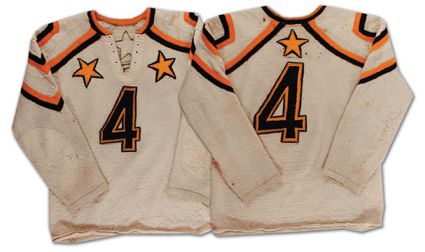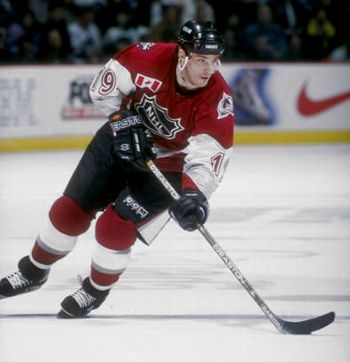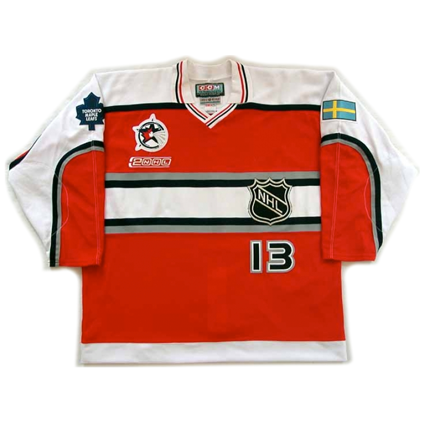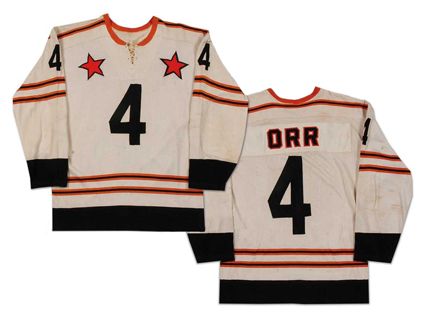Wednesday, January 26, 2011
1969 NHL All-Star Game Bobby Orr Jersey
All-Star Week continues with a look at the evolution of the various formats for the All-Star Game, which begins with the first change in jersey style and then it's move to a mid-season point in the schedule.
After wearing the same jerseys for every All-Star Game since it's inception in 1947, the players on the All-Star team were outfitted with a new style of jersey in 1960 for the sixth game staged in Montreal. This style was used four times through the game in 1963.
A 1960 NHL All-Star jersey worn by Red Kelly of the Toronto Maple Leafs
After 20 years with a spot on the calendar to kick off the new season, the NHL All-Star Game was moved to the middle of the season beginning with the 1966-67 season. With the 19th annual game being held before the season in October of 1965 and the 20th scheduled for mid-season on January 18, 1967, it meant that the 15 month gap between games would mean no game was held during the 1966 calendar year.
The format which pitted the defending Stanley Cup champion versus a team of All-Stars comprised of members of the remaining five member clubs of the NHL was retained for 1967 and 1968, but the changing face of the NHL, now expanded to 12 clubs with the great expansion of 1967-68, led to a change in format.
In addition to the much longer lag time between a team winning the cup in early May and playing in the All-Star Game now increased from six months to ten, there was also the factor of one team consisting of players from a single club versus a team made up of players from 11 different clubs, limiting the opportunities for players not members of the Stanley Cup champions to participate in the contest. The new format debuted on January 21, 1969 when the Eastern Conference All-Stars met the Western Conference All-Stars in a 3-3 tie in Montreal, which certainly must have been a moral victory from the players from the Western Conference made up of the six new expansion clubs.
This change also let to a team being selected to host the All-Star Game, rather than earning the right to host it by being the defending champions, which assured the upstart expansion clubs an opportunity to host the game, which some of them still would have yet been able to do under the old system! Under the previous system where the defending champions hosted the game, the Montreal Canadiens and Toronto Maple Leafs monopolized the game, each hosting it eight times in 21 years, with four games in Detroi and one in Chicago, while the Boston and New York were both completely excluded!
Still, the first East/West game was held in Montreal but quickly visited St. Louis, Boston, Minnesota, New York and Chicago over the next five seasons. The game was still conference versus conference in 1975, but a league wide realignment saw the names of the teams change as the best of the Campbell Conference would now take on the stars of the Wales Conference. Over the next 19 seasons 17 games were held under the Wales versus Campbell format until a return to the East versus West nomenclature for three events.
1998 saw a major change in format for the first time since 1969 when, in an effort to promote the NHL's star players appearing in the 1998 Olympic Games in Nagano, Japan, a new concept was unveiled which pitted players from North America taking on a team comprised of players from the rest of the globe. The concept saw some unusual circumstances, as for the first time ever, teammates from the same NHL club would now be facing off against each other, such as when the Colorado Avalanche's Joe Sakic and Patrick Roy of Canada lined up against teammates Latvian Sandis Ozolinsh, Swede Peter Forsberg, Finn Jari Kurri and Russian Valeri Kamensky. Fans of the host Canucks had to decide between supporting the North American team, which featured their club's captain Mark Messier, or cheering for their popular high scoring sniper Pavel Bure of Russia, despite the fact he was a member of the "visiting" World team.
The jerseys during this era contained nearly as many patches as a NASCAR driver's uniform, as each player wore a patch with the logo of the game, the team they were representing and a flag from their country of origin.
After two years wearing some rather striking jerseys, the most unusual designs in the history of the game made their appearance at the 2000 edition in Toronto for the milestone 50th game in All-Star history. Fueled by the buzz surrounding the millennium, the jerseys were of a futuristic design, with the North Americans wearing blue and the World team wearing red, while the goalies for both teams wore white jerseys! If all that was not enough, in addition to the aforementioned three patches worn on this style, the jerseys in 2000 also had the addition of the NHL 2000 patch. Overall, the jerseys were only slightly less acceptable that Major League Baseball's Turn Ahead the Clock silliness.
The game once again returned to the East against the West format in 2003, which remained in effect until this season, when a new concept will be put into service in which the two captains, voted on by the All-Stars, Nicklas Lidstrom and , will engage in a draft during which they will select their own teams from the pool of All-Stars just two days prior to the All-Star Game in an effort to breathe some new life and generate renewed interest in the game, which as been criticized for it's high scoring, low intensity contests which lack any hitting or defensive play.
This new "fantasy draft" concept certainly has people talking, as it once more raises the possibility of teammates competing against each other and will leave one man with the stigma of being the last player taken. It's possible that this new drafting procedure will generate more discussion than the game itself!
The news on the jersey front is that each player will be allowed to wear his regular number from his NHL club, even if there are other members of his All-Star squad who wear the same one. Many long time fans no doubt recall Sakic having to wear #91 in deference to Steve Yzerman wearing his #19, or Theo Fleury in the unusual #74 when his #14 was claimed by a player with more seniority.
Today's featured jersey is a 1969 NHL All-Star Game Bobby Orr jersey as worn during the first NHL All-Star Game played with the new East vs. West format, following the first 21 games which almost exclusively featured a team of All-Stars taking on the defending Stanley Cup champions.
This style of jersey was first used in 1964 without names on the back, which were added for the 1969 contest, perhaps due to television demands or perhaps with the recent league expansion, due to a lack of familiarity with the approximately 120 new players in the NHL! This jersey was used until 1972, a run of nine games.
The 1969 All-Star Game was Orr's second of eight consecutive in which he would play.
Labels:
NHL All-Star Game,
Orr Bobby
Subscribe to:
Post Comments (Atom)















No comments:
Post a Comment
We welcome and encourage genuine comments and corrections from our readers. Please no spam. It will not be approved and never seen.